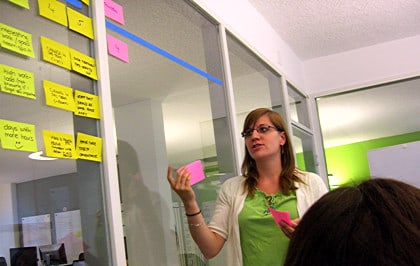
Last week, we had a Scrum Workshop Day at Liip's Fribourg office. For the first presentation of the morning, I introduced the group to the Happiness Metric. We all had a go, and talked about what makes us happy and what not.
The Happiness Metric is a tool for agile teams to find out how everyone feels about the company and the work they are currently involved in. The metric over time shows how the team is doing and how it has evolved. At Liip we care about the happiness and well-being of our employees, and we always try to remember that work should also be fun. Talking about happiness in a structured way seems to be a good thing, so the interest to get to know the method was high among Liipers.
Jeff Sutherland introduced the Happiness Metric to me in a talk he gave at a TriFork GOTO Night in Zurich this last March. Jeff specifically referred to the practices of the Swedish company Crisp. He pointed to the blog post where Henrik Kniberg of Crisp talks about how he uses the Happiness Metric “as the primary metric to drive his company”.
The 4 questions of the Happiness Metric
Basically, for the Happiness Metric each team member answers four questions.
- How happy are you with your company? (scale 1-5)
- What feels best right now?
- What feels worst right now?
- What would increase your happiness index?
For our first trial of the Happiness Metric, I chose a quarterly retrospective, a meeting each scrum team has four times a year to discuss team issues, strengths and weakness in order to set goals and identify improvements. Normally, a member of Liip management attends those team retrospectives, so it seemed to be a perfect opportunity to let the management know how people feel about the company.
Since we are all familiar with sticky notes in agile teams I suggested we write the answers on Post-it notes and stick them on the wall, each member in turn. Whoever felt like doing so could also give a short comment on his or her answers. For issues that came up multiple times, we raised a team impediment in the impediment backlog. We agreed to take immediate action when any person's happiness number fell below a two. In some cases it it might have been necessary for the Scrum Master to talk with someone 1-to-1 to find out whether the matter was too personal to be shared with the team.
It is still the subject of debate whether it would be best to ask for the Happiness Metric in the beginning of a team retrospective or at the end. If you ask about happiness at the beginning of the retrospective, team members might tend to give a low happiness index for unspoken issues. After the retrospective, when those issues were discussed in a solution-oriented way, the happiness index might tend to be higher. Also we couldn't decide whether it is better to start or to end the meeting in a more personal mood compared to the issue-oriented discussion of the regular retrospective.
We are not as advanced with the Happiness Metric as Crisp is yet. We aren't using the metric with everyone in the company. We don't report the answers in a spreadsheet. Also we don't ask each employee to update the index every month. These are options we will explore to find out what makes sense for our teams. Management was clear during the workshop about how important it is for them to have happy employees at Liip. They want to know how people feel at work. Therefore, the Happiness Metric might well find a place in our company's agile toolbox.
